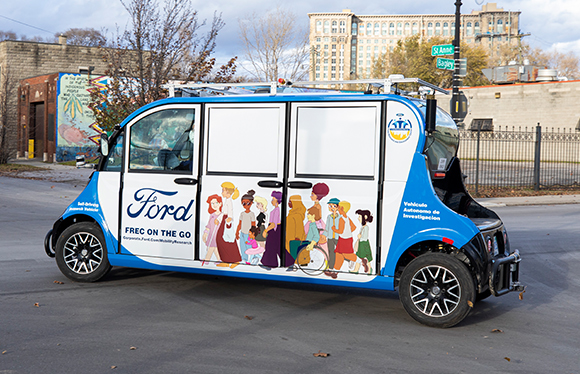
Ford Mobility Research in the Michigan Central Impact Area
Ford Motor Company is committed to helping build a better world where every person is free to move and pursue their dreams.
Ford is conducting pilots and testing in and around the Michigan Central impact area to build mobility solutions for the future.

As part of this effort, Ford and its philanthropic arm, Ford Motor Company Fund, have launched an autonomous fresh food delivery pilot, which is expected to bring 10,000 pounds of fresh food to the doorsteps of senior citizens in Southwest Detroit.
Over the next six months, residents who have opted into the program at the Rio Vista Co-Op Apartments senior living center will receive two deliveries each month of fresh produce and food delivered via Ford’s autonomous shuttle. Residents’ feedback was incorporated from the food to the bags being used. This service is being integrated with the Ford Fund’s existing operations, FREC on the GO, to deliver healthy foods to the community.
Ford will be testing the autonomous technology and researching how to build future services while addressing a need in the community. Here is what residents can expect:
- The delivery shuttle is autonomous which means it has the technology onboard needed to be able to steer, accelerate, slow down and stop by itself.
- Safety is a top priority. While the vehicle has the ability to drive on its own, there will always be a human safety operator inside who is monitoring the vehicle and can take over if needed. The vehicle also will use three multiple smart infrastructure nodes along the route, to help it “see” around corners for an added layer of safety.
- The shuttle will operate around the Hubbard-Richard neighborhood – going between the Ford Resource and Engagement Center and the Rio Vista Co-Op Apartments.
- A maximum of three low-speed shuttles will operate at speeds of up to 25 mph.
- The shuttle will operate autonomously Monday to Friday during daylight hours and make deliveries twice a month.
- The Southwest Detroit community is represented through an inclusive piece of artwork designed by Detroit School of Arts student, Brooke Snow.
We are excited to bring you along in this journey as we build the future of mobility.
HOW THE AUTONOMOUS SHUTTLE WORKS
This shuttle research concept brings together three elements to form a safe, autonomous driving operation: 1. The electric shuttles with onboard autonomy. 2. Ford-designed smart infrastructure nodes, and 3. Remote teleoperations center.
Part 1. Meet the Shuttles: Ford is conducting this research with three low-speed electric shuttles affectionately nicknamed Bumblebee [mapping vehicle], Cuttlefish [the autonomous delivery shuttle] and Aardvark [the autonomous delivery shuttle back-up]. Each is unique and designed to accomplish a different job so you might see one, or three at any given time!

Part 2. Ford-Designed Smart Infrastructure Nodes: Serve ONLY to help an autonomous vehicle navigate, providing an added layer of safety for all road users! The team has installed three Ford-designed smart infrastructure sensor nodes along the shuttle test route.
The Ford nodes can relay information to a self-driving vehicle, so it knows what’s happening on the ground before it even arrives at an intersection or other piece of roadway. For example, if the vehicles’ sensors are blocked by a truck, the node helps the vehicle to see that a pedestrian is approaching.
This isn’t the first time Ford has installed these – it has been operated with Ford’s autonomous vehicles in Saline, Michigan and Miami, Florida.
Note: Data captured by the smart infrastructure node is not shared with any third-parties, law enforcement or government agencies; it is strictly used within Ford to create a safe experience for all road users.

Part 3. Additional Safety Layer: Ford’s shuttles are intended to operate autonomously and have a human safety operator, but what about those times when unforeseen circumstances occur? Last summer, for instance, Detroit saw severe storms resulting in tree branches falling in the streets. Ford is testing remote capabilities which could be used in a future mobility service to have a designated operator take control of a shuttle and drive around a problem area.

FAQ
- Why is Ford conducting this research? Ford is testing and researching a variety of solutions in and around the Michigan Central impact area to help improve mobility and how people and goods move in the future. We believe there are a variety of autonomous form factors that could be used in the future to move people and goods, this research is a part of that. We are excited to test new forms of technology, while also giving back to the community!
- When will the autonomous testing start? We have already begun testing our autonomous operations and recently launched the delivery pilot which will run until the summer of 2022.
- Is this the first time the shuttle will operate autonomously? Safety is Ford’s top priority. Before operating on public roads, Ford gathered on-road data to understand the traffic environment and has been conducting ongoing testing at the Mcity proving grounds in Ann Arbor before testing autonomously on public roads.
- Are the shuttles you are using Ford vehicles? Ford is using modified Polaris GEM electric vehicles that have been outfitted with a self-driving system.
- How many shuttles are you operating? We are operating a total of three shuttles -- a primary autonomous shuttle we will use to make deliveries, a back-up autonomous shuttle, as well as a data collection shuttle.
- What kinds of sensors are being used on the vehicles? Ford has equipped the shuttle with a self-driving system which includes – lidar, radar, cameras and sensors – which are key enablers for a vehicle to operate autonomously.
- How fast will you be going? Ford will be operating at low speeds, up to 25 mph following all speed limits.
- When will these vehicles be operating? Ford will be operating our vehicles Monday – Friday. The autonomous vehicle will only operate during the day, and the manually driven vehicle could operate in the evening hours.
- What are the boundaries of where these vehicles will operate? Ford is operating its vehicles within the Michigan Central impact area – within the Hubbard Richard neighborhood along a route between the Ford Resource and Engagement Center (FREC) and Rio Vista Co-Op Apartments senior living center. Residents could expect to see the vehicles in and around this area.
- How can I sign-up for fresh food delivery? The FREC on the GO food deliveries provided by Ford Fund are available until the program reaches capacity. If you live within the program area and are interested in receiving a fresh food delivery in the future, please reach out to 313-806-0370.
- Can I sign-up to have this autonomous shuttle deliver me food? Right now, we are working directly with Rio Vista for this specific autonomous delivery pilot. If you’d like to find out more information about the Ford Fund’s broader delivery program, FREC on the GO! that is in association with the Ford Resource and Engagement Centers, you can reach out to 313-806-0370.
- How will the delivery work? The autonomous shuttle will arrive at the FREC and the Ford team will load the produce bags supplied from Gleaner’s Community Food Bank. The shuttle will then drive autonomously to Rio Vista. From there, the Ford team and Rio Vista will unload the produce bags and will take them to each resident who has opted into the service.
- Why was Rio Vista selected? Rio Vista is an existing recipient of FREC on the GO. We identified that there was a need with residents lacking access to fresh foods due to mobility issues and wanted to help address that.
- What kind of technology is on the Ford infrastructure smart node? The Ford-designed infrastructure nodes are designed to serve only to help an autonomous vehicle navigate complex and crowded intersections. The nodes are equipped with lidar, radar, cameras and sensors – which is the same technology on an autonomous vehicle which allows it to see and navigate without a human driver. This combination of sensor technology – lidar, radar, and cameras – enables Ford’s nodes to communicate with its autonomous shuttle to help provide it with as much information as possible. As a result, this provides an added layer of safety.
- How does the infrastructure node work? Situated above an intersection, Ford’s infrastructure node can get a comprehensive view of what’s happening in all directions and offer a “bird’s eye view” of knowledge to support an autonomous vehicle, which is also analyzing its immediate surroundings at the street-level at the same time. Equipped lidar, radar, cameras and sensors, the Ford infrastructure node quickly relays information to its autonomous vehicles to let them know what they are driving towards as they approach an area or situation.
- What types of data is being captured on the Ford infrastructure smart nodes? The Ford infrastructure node serves only one purpose – to help an autonomous vehicle navigate complex and crowded intersections. By design, the nodes are not capable of capturing personally identifiable information or license plate detection. The technology only detects silhouettes of objects such as a static sign, or a moving car or bicyclists, so the autonomous vehicle knows how to predict behavior and make smart decisions.
- Is this type of data shared with third parties? Data captured by the smart infrastructure node is not shared with any third-parties, law enforcement or government agencies. It is strictly used within Ford to help the autonomous vehicle communicate and for technology development purposes.
- Why do you need the infrastructure node? The Ford-designed infrastructure nodes provide an added layer of safety for autonomous vehicles to provide them with as much information as possible to help it navigate complex and crowded intersections. For example, if a bus or truck is blocking the autonomous vehicle sensors’ direct line of sight, the vehicle can know even quicker if another vehicle is approaching from around the corner at an unsafe speed.
- Will the Ford infrastructure smart node always be “on”? No. The Ford infrastructure smart node serves only one purpose – to help an autonomous vehicle navigate complex and crowded intersections. As a result, our nodes will only be utilized when our autonomous vehicle is operating.
- Is this the first time Ford has used its infrastructure node? No. Ford has already conducted research in Saline, Michigan and Miami, Florida.
- Will the infrastructure node be removed after the research has concluded? Yes. Ford is responsible for removing the technology at the conclusion of the research.
DIVE DEEPER
You can learn more about Ford’s autonomous delivery pilot in this press release and blog.


